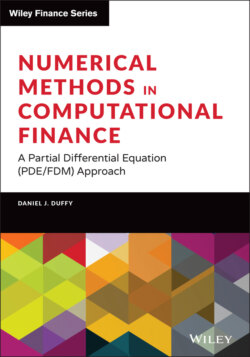Читать книгу Numerical Methods in Computational Finance - Daniel J. Duffy - Страница 43
2.4.2 Scalar Non-Linear Problems and Predictor-Corrector Method
ОглавлениеReal-life problems are very seldom linear. In general, we model applications using non-linear IVPs:
(2.28)
Here is a non-linear function in u in general. Of course, Equation (2.28) contains Equation (2.1) as a special case. However, it is not possible to come up with an exact solution for (2.28) in general, and we must resort to some numerical techniques. Approximating (2.28) poses challenges because the resulting difference schemes may also be non-linear, thus forcing us to solve the discrete system at each time level by Newton's method or some other non-linear solver. For example, consider applying the trapezoidal method to (2.28):
(2.29)
where is non-linear. Here see that the unknown term u is on both the left- and right-hand sides of the equation, and hence it is not possible to solve the problem explicitly in the way that we did for the linear case. However, not all is lost, and to this end we introduce the predictor-corrector method that consists of a set consisting of two difference schemes; the first equation uses the explicit Euler method to produce an intermediate solution called a predictor that is then used in what could be called a modified trapezoidal rule:
(2.30)
The predictor-corrector is used in practice; it can be used with non-linear systems and stochastic differential equations (SDE). We discuss this topic in Chapter 13.
